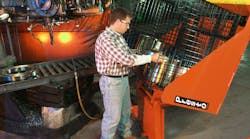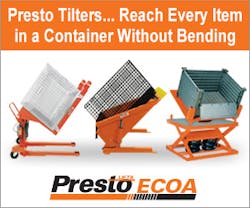Worker fatigue is getting expensive. Employers lose more than $130 billion a year in productivity due to worker fatigue, according to the National Safety Council. In fact, it’s become such a concern that a report released early this year highlighted the need to capture worker fatigue data.
The American Society of Safety Professionals (ASSP) Foundation report focused on the use of sensors to measure worker fatigue. ASSP noted that 57.9% of U.S. manufacturing workers said they were somewhat fatigued during the past week. The ability to capture fatigue-related data is an important step toward understanding risk factors. Data collection may help organizations determine how their material handling equipment is impacting their safety performance and overall productivity.
Studies have shown that repetitive bending or reaching for items can result in injuries and decrease efficiencies. Advancements in material handling solutions, such as powered tilters and upenders, can minimize these movements by bringing containers or material closer to workers, says Rick daSilva, national sales manager for material handling equipment provider Presto ECOA Lifts.
“It’s awkward reaching down into a container to remove the last product,” daSilva says. “Also, loading or packaging items can be challenging if the box is very tall, and it can be awkward to get the product out. Tilting the container allows you to load and unload in an ergonomic position. The benefits are increased productivity and less worker fatigue.”
Another benefit is product integrity, daSilva says. Tilters decrease the risk of dropping a product when removing it or loading it into a container because everything is within hand’s reach.
“If you’re reaching down when you’re loading up an empty container, you could damage the product by having to drop it down to the bottom of the container,” daSilva explains. “So by tilting the container, we can minimize the reaching and dropping of the product.”
Tilters for any Task
Workers may handle a wide range of container or unit sizes as demand increases for more product varieties and features. Material handling equipment manufacturers are offering tilters for various object dimensions and weights to accommodate wider product variations. Tilters are available as tilt-only units or units that can lift and tilt, daSilva says. Presto’s PT and PTS battery-powered portable container tilters are available in 2,000 or 4,000 lb. capacities. They can tilt containers to any angle between 0 and 85 degrees. The tilters have self-contained batteries and chargers, so users don’t have to worry about plugging in the units in the work cell, which provides additional mobility, daSilva says.
The portability of the tilters also eliminates the need for a separate unit, such as a forklift or pallet truck, to move a container or product from another location in the facility to the point of use. Some of the common applications that the PT and PTS handle include parts-feeding and packaging operations.
Material handling manufacturers also are offering customized tilters for other types of applications, including access to electrical cabinets. For example, Presto customizes tilters that can safely position electrical cabinets toward a worker.
“The center of gravity on an object like that requires a different style of tilter,” daSilva explains. “And the pivoting on a container tilter can’t be the same as it is for a cabinet, so we have several series of tilters that we utilize for custom tilters.”
Presto will evaluate the center of gravity of the item and the degree of tilt necessary to position the item and the height of the object when customizing a tilter, daSilva says. Another option is the ability to place a lift table underneath a tilter to raise and lower items. This feature improves accessibility for both short and tall workers.
“One shift may have a shorter worker in a cell and another shift may have a taller worker,” daSilva says. “Their requirements for ergonomics are going to vary, so having the ability to lift and tilt is important.”
Upenders do the Heavy Lifting
Heavier loads, such as steel coils or rolled material, may require a type of tilter called an upender. Manufacturers may need to rotate the roll or coil 90 degrees to feed a machine. Presto has designed upenders with the capacity to handle up to 50,000 lbs. Upenders are typically pit mounted or floor mounted and loaded with a forklift or overhead crane.
Upenders are typically more cost effective than other options on the market that tilt or rotate heavier items. “There are fork truck accessories that can manipulate the load that are a lot more money, and upenders are going to allow you to handle a greater weight range,” daSilva says.
Like tilters, upenders allow workers to access items with minimal exertion and movement, which increases productivity and reduces the potential for injuries, daSilva says.














